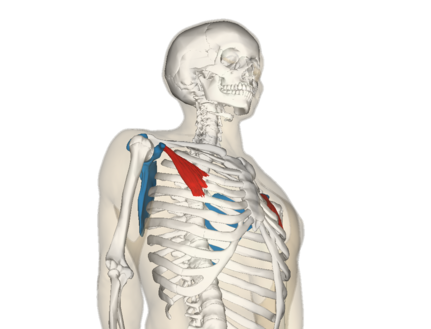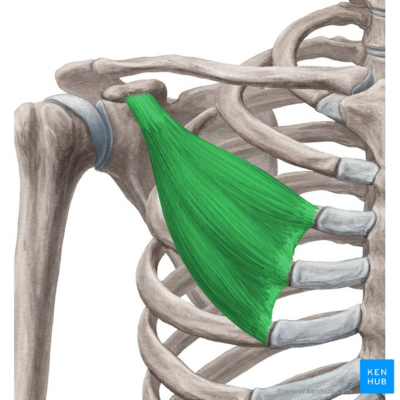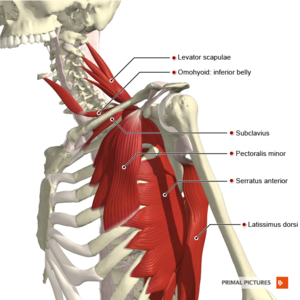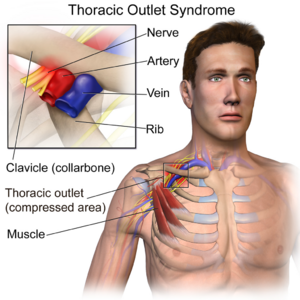Pectoralis Minor: Difference between revisions
Ahmed Nasr (talk | contribs) No edit summary |
Joao Costa (talk | contribs) No edit summary |
||
| (18 intermediate revisions by 3 users not shown) | |||
| Line 4: | Line 4: | ||
'''Top Contributors''' - {{Special:Contributors/{{FULLPAGENAME}}}} | '''Top Contributors''' - {{Special:Contributors/{{FULLPAGENAME}}}} | ||
</div> | </div> | ||
[[File:Pectoralis minor.png| | == Description == | ||
[[File:Pectoralis minor muscle and shoulder blade.png|right|frameless|alt=|431x431px]] | |||
The pectoralis minor is triangular in shape and is located under the [[pectoralis major]], and both form the anterior wall of the axilla. | |||
It originates from the margins of the third to fifth [[ribs]] adjacent to the [[Costochondritis|costochondral]] junction. The fibers consequently pass upward and laterally to insert into the medial border and superior surface of the coracoid process of the [[scapula]]. | |||
It is crucial in the stabilization of the scapula by pulling it downward and anteriorly against the thoracic wall.<ref name=":3">Baig MA, Bordoni B. [https://www.ncbi.nlm.nih.gov/books/NBK545241/ Anatomy, Shoulder and Upper Limb, Pectoral Muscles].Available:https://www.ncbi.nlm.nih.gov/books/NBK545241/ (accessed 8.1.2022)</ref> | |||
The pectoralis minor muscle creates a passage between the ribs for the transit of the brachial plexus and both the subclavian artery and vein. If the muscle is shortened/tight this abnormal tension: negatively affecting the [[Scapulohumeral Rhythm]]; can also cause [[Thoracic Outlet Syndrome (TOS)|thoracic outlet syndrome]]<ref name=":3" />.<ref name=":0">kenhub.Pectoralis minor muscle. Available from:https://www.kenhub.com/en/library/anatomy/pectoralis-minor-muscle (accessed 20 July 2018).</ref><ref name=":2">Keith L. , Anne M. R . Clinically Oriented Anatomy seventh edition . philidephia : Lippincott Williams & Wilkins.Feb 13, 2013</ref> | |||
The pectoralis minor | |||
'''Image 1: Pectoralis Minor muscle (red) and shoulder blade (blue).''' | |||
== Anatomy == | == Anatomy == | ||
[[File:Pectoralis minor muscle - Kenhub.png|alt=Pectoralis minor muscle (highlighted in green) - anterior view|right|frameless|400x400px|Pectoralis minor muscle (highlighted in green) - anterior view]] | |||
'''Origin''' | |||
The base of pectoralis minor is formed by fleshy slips arising from the anterior third to fifth ribs, close to the costal cartilage. Variations in the origin of the muscle is common.<ref name=":0" /><ref name=":2" /> | |||
'''Insertion''' | |||
The apex of the triangle inserts into the medial border and upper surface of coracoid process of the scapula.<ref name=":0" /><ref name=":2" /> | |||
'''Image 2: Pectoralis minor muscle (highlighted in green) - anterior view.<ref >Pectoralis minor muscle (highlighted in green) - anterior view image - © Kenhub https://www.kenhub.com/en/library/anatomy/pectoralis-minor-muscle</ref>''' | |||
Pectoralis minor | |||
'''Nerve and Arterial Supply''' | |||
# Its main [[Neurone|nerve]] supply is from the medial pectoral nerves ( C8, T1 ). It may also be innervated by the lateral pectoral nerve via a communicating branch known as 'ansa pectoralis',<ref name=":0" /> | |||
# The [[Blood Physiology|blood]] vessel that supplies the pectoralis minor muscle is the thoracoacromial [[Arteries|artery]]; a short artery that branches off from the larger axillary artery of the chest and upper extremities.<ref>Study.com. Pectoralis Minor: Function, Blood Supply & Innervation. Available from:https://study.com/academy/lesson/pectoralis-minor-function-blood-supply-innervation.html (accessed 20 July 2018).</ref> | |||
Image: Pectoralis minor muscle (highlighted in green) - anterior view | |||
== | == Function == | ||
The | [[File:Muscles connecting the upper limb to the trunk deep muscles Primal.png|right|frameless]] | ||
The primary actions of this muscle include the stabilization, depression, abduction or protraction, internal rotation and downward rotation of the scapula. | |||
* When the ribs are immobilized, this muscle brings the scapula forward, | * When the ribs are immobilized, this muscle brings the scapula forward, | ||
* Both pectoralis muscles work with the serratus anterior muscles to create | * Both pectoralis muscles work with the [[Serratus Anterior|serratus anterior]] muscles to create full range of movement for the scapula.<ref>health line. Pectoralis minor. Available from: https://www.healthline.com/human-body-maps/pectoralis-minor#1 \(accessed 20 July).</ref> | ||
Pectoralis Minors role in respiration (see [[Muscles of Respiration|muscles of respiration]]) | |||
* Elevates the ribs for deep inspiration when the pectoral girdle is fixed or elevated. | |||
* With the scapula stabilized, in a position of good alignment, the pectoralis minor acts as an accessory muscle of inspiration. <ref name=":1">Kendall F, McCreary E, Provance P,Rodgers M,Romani W. Muscles:Testing and function with posture and pain. 5th ed. Philadelphia: Lippincott Williams & Wilkins, 2005.</ref> | |||
When the ribs are immobilized, this muscle brings the scapula forward, | |||
'''Image 3: Pectoralis minor and Serratus anterior can both be seen here.''' | |||
== | == Physiotherapy Relevance == | ||
[[File:Chris-benson-yx-iJFybOBQ-unsplash.jpg|right|frameless]] | |||
Many issues that can present as a result of pectoralis muscle dysfunctions, most commonly are due prolonged slouched positions. This can result in pain and/or restriction in neck movements and stiffness and pain in the upper back and increase risk of [[Rotator Cuff Tendinopathy|rotator cuff]] pathologies.<ref>Get active physio [https://getactivephysio.com.au/pec-minor-and-its-major-impacts/ Pec minor and its major impact] Available: https://getactivephysio.com.au/pec-minor-and-its-major-impacts/ (accessed 8,1,2022)</ref> | |||
</ref> | |||
* | * A shortened pectoralis minor restricts flexion of the shoulder joint by limiting scapular rotation and preventing the glenoid cavity from attaining the cranial orientation necessary for complete flexion of the joint. <ref name=":1" /> It also causes to [[Winged scapula|winging of the scapula]] ie prominence of the medial border of the scapula with anterior tilting, together with prominence of the inferior angle and depression of the coracoid process. | ||
[[File:Thoracic Outlet Syndrome.png|right|frameless]]See [[Forward Head Posture]], [[Upper-Crossed Syndrome]], | |||
[[Thoracic Outlet Syndrome (TOS)|Thoracic outlet syndrome]]. With the cords of brachial plexus and the axillary blood vessels lying between the coracoid process and the rib cage, shortening of pectoralis minor may produce impingement on these large vessels and nerves, causing shoulder impingement and thoracic outlet syndrome.<ref name=":4">Castelein, B., Cagnie, B., Parlevliet, T., Cools, A. [https://www.sciencedirect.com/science/article/abs/pii/S1356689X15002520?via%3Dihub Serratus anterior or pectoralis minor: Which muscle has the upper hand during protraction exercises?.] Manual Therapy,April 2016: 22, 158–164. </ref> | |||
Trigger points | |||
[[Trigger Points|Trigger points]] in pectoralis minor have almost identical referred pain patterns as in pectoralis major muscle.These pain patterns start in the front of shoulder and can extend down the inside of the arm, elbow, forearm, palm of the hand, and into the pinky, ring, and middle fingers. A tense pectoralis minor muscle can also entrap nerves in the armpit region causing pain, numbness, and tingling down the arm and into the hand.<ref>trigger point therapist. Pectoralis minor. Available from:http://www.triggerpointtherapist.com/?s=pectoralis+minor (accessed 19 July 2018).</ref> | |||
== Assessment == | == Assessment == | ||
Start with this good 3 minute video on the Pectoralis Minor titled Palpation, Manual Therapy and Stretch{{#ev:youtube|v-ZM13q-0dc}}'''Palpation''' | |||
= | To palpate the pectoralis minor muscle a place a finger in the axilla and pushing obliquely towards the coracoid process of the scapula. If it is sore, the muscle is in spasm<ref name=":3" />. | ||
'''Strength''' | |||
Patient position: Lying supine | |||
* Action: Patient leaves arm at side while forcing their coracoid process forward, examiner applies resistance at the coracoid process | |||
* Gravity eliminate position: Seated<ref>Weebly.Muscles of the shoulder Available: https://shouldercomplexgocatsnmu.weebly.com/manual-muscle-testing.html (accessed 8.1.2022)</ref> | |||
'''Length''' | |||
Position: Patient is supine with the arms at the sides, elbows extended, palms upward, knees bent and lower back flat on the table. | |||
Test: The examiner stands at the head of the table and observes the position of the shoulder girdle. The amount of tightness is measured by the extent to which the shoulder is raised from the table and by the amount of resistance to downward pressure on the shoulder. Tightness may be recorded as slight, moderate, or marked. | |||
{{#ev:youtube| | == Treatment == | ||
'''I'''f you want to activate serratus anterior and minimize the work or activity of Pectoralis minor implement exercises that have highly selective activation for serratus anterior not pectoralis minor. The most effective exercises are :<ref name=":4" /> | |||
*[[Serratus Anterior Strength Test or ( Punch out test )|Serratus Punch Exercise]] : it is highly selective to serratus anterior. | |||
* The Modified [[Pushups|Push-Up]] Plus Exercise: both on the floor and and against the wall version, with emphasis on the concentric phase of the exercise. | |||
{| width="100%" cellspacing="1" cellpadding="1" | |||
|- | |||
|{{#ev:youtube|sotib3k3oxw|300}} | |||
|{{#ev:youtube|SsTi7ueuDTU|300}} | |||
|} | |||
=== Stretching === | === Stretching === | ||
The first 4 minute video is titled: Chest Stretch for Tight or Sore Muscles: Pectoralis Major and Minor | |||
The second 8 minute video is titled: Most Important Chest Stretches to Correct Forward Rounded Shoulders and Pinched Nerve. | |||
{| width="100%" cellspacing="1" cellpadding="1" | {| width="100%" cellspacing="1" cellpadding="1" | ||
|- | |- | ||
| Line 81: | Line 101: | ||
<br> | <br> | ||
=== Manual | === Manual Therapy === | ||
Video 1: Pectoralis Minor Static Manual Release (Soft Tissue Mobilization), 8 minutes. | |||
Video 2: Massage Technique: Myofascial chest stretch. 2 minutes. | |||
{| width="100%" cellspacing="1" cellpadding="1" | {| width="100%" cellspacing="1" cellpadding="1" | ||
|- | |- | ||
| Line 89: | Line 112: | ||
<br> | <br> | ||
== | == See also== | ||
*[[Pectoralis major|Pectoralis major]] | *[[Pectoralis major|Pectoralis major]] | ||
*[[Muscles of Respiration|Muscles of Respiration]] | *[[Muscles of Respiration|Muscles of Respiration]] | ||
*[[Winged scapula|Winged scapula]] | *[[Winged scapula|Winged scapula]] | ||
== References == | |||
== | |||
<references /> | <references /> | ||
| Line 102: | Line 123: | ||
[[Category:Anatomy]] | [[Category:Anatomy]] | ||
[[Category:Muscles]] | [[Category:Muscles]] | ||
[[Category:Shoulder - Muscles]] | |||
Latest revision as of 06:18, 29 March 2022
Original Editor - Esraa Mohamed Abdullzaher
Top Contributors - Ilona Malkauskaite, Lucinda hampton, Esraa Mohamed Abdullzaher, Joao Costa, Ahmed Nasr and Kim Jackson
Description[edit | edit source]
The pectoralis minor is triangular in shape and is located under the pectoralis major, and both form the anterior wall of the axilla.
It originates from the margins of the third to fifth ribs adjacent to the costochondral junction. The fibers consequently pass upward and laterally to insert into the medial border and superior surface of the coracoid process of the scapula.
It is crucial in the stabilization of the scapula by pulling it downward and anteriorly against the thoracic wall.[1]
The pectoralis minor muscle creates a passage between the ribs for the transit of the brachial plexus and both the subclavian artery and vein. If the muscle is shortened/tight this abnormal tension: negatively affecting the Scapulohumeral Rhythm; can also cause thoracic outlet syndrome[1].[2][3]
Image 1: Pectoralis Minor muscle (red) and shoulder blade (blue).
Anatomy[edit | edit source]
Origin
The base of pectoralis minor is formed by fleshy slips arising from the anterior third to fifth ribs, close to the costal cartilage. Variations in the origin of the muscle is common.[2][3]
Insertion
The apex of the triangle inserts into the medial border and upper surface of coracoid process of the scapula.[2][3]
Image 2: Pectoralis minor muscle (highlighted in green) - anterior view.[4]
Nerve and Arterial Supply
- Its main nerve supply is from the medial pectoral nerves ( C8, T1 ). It may also be innervated by the lateral pectoral nerve via a communicating branch known as 'ansa pectoralis',[2]
- The blood vessel that supplies the pectoralis minor muscle is the thoracoacromial artery; a short artery that branches off from the larger axillary artery of the chest and upper extremities.[5]
Image: Pectoralis minor muscle (highlighted in green) - anterior view
Function[edit | edit source]
The primary actions of this muscle include the stabilization, depression, abduction or protraction, internal rotation and downward rotation of the scapula.
- When the ribs are immobilized, this muscle brings the scapula forward,
- Both pectoralis muscles work with the serratus anterior muscles to create full range of movement for the scapula.[6]
Pectoralis Minors role in respiration (see muscles of respiration)
- Elevates the ribs for deep inspiration when the pectoral girdle is fixed or elevated.
- With the scapula stabilized, in a position of good alignment, the pectoralis minor acts as an accessory muscle of inspiration. [7]
When the ribs are immobilized, this muscle brings the scapula forward,
Image 3: Pectoralis minor and Serratus anterior can both be seen here.
Physiotherapy Relevance[edit | edit source]
Many issues that can present as a result of pectoralis muscle dysfunctions, most commonly are due prolonged slouched positions. This can result in pain and/or restriction in neck movements and stiffness and pain in the upper back and increase risk of rotator cuff pathologies.[8]
- A shortened pectoralis minor restricts flexion of the shoulder joint by limiting scapular rotation and preventing the glenoid cavity from attaining the cranial orientation necessary for complete flexion of the joint. [7] It also causes to winging of the scapula ie prominence of the medial border of the scapula with anterior tilting, together with prominence of the inferior angle and depression of the coracoid process.
See Forward Head Posture, Upper-Crossed Syndrome,
Thoracic outlet syndrome. With the cords of brachial plexus and the axillary blood vessels lying between the coracoid process and the rib cage, shortening of pectoralis minor may produce impingement on these large vessels and nerves, causing shoulder impingement and thoracic outlet syndrome.[9]
Trigger points
Trigger points in pectoralis minor have almost identical referred pain patterns as in pectoralis major muscle.These pain patterns start in the front of shoulder and can extend down the inside of the arm, elbow, forearm, palm of the hand, and into the pinky, ring, and middle fingers. A tense pectoralis minor muscle can also entrap nerves in the armpit region causing pain, numbness, and tingling down the arm and into the hand.[10]
Assessment[edit | edit source]
Start with this good 3 minute video on the Pectoralis Minor titled Palpation, Manual Therapy and Stretch
Palpation
To palpate the pectoralis minor muscle a place a finger in the axilla and pushing obliquely towards the coracoid process of the scapula. If it is sore, the muscle is in spasm[1].
Strength
Patient position: Lying supine
- Action: Patient leaves arm at side while forcing their coracoid process forward, examiner applies resistance at the coracoid process
- Gravity eliminate position: Seated[11]
Length
Position: Patient is supine with the arms at the sides, elbows extended, palms upward, knees bent and lower back flat on the table.
Test: The examiner stands at the head of the table and observes the position of the shoulder girdle. The amount of tightness is measured by the extent to which the shoulder is raised from the table and by the amount of resistance to downward pressure on the shoulder. Tightness may be recorded as slight, moderate, or marked.
Treatment[edit | edit source]
If you want to activate serratus anterior and minimize the work or activity of Pectoralis minor implement exercises that have highly selective activation for serratus anterior not pectoralis minor. The most effective exercises are :[9]
- Serratus Punch Exercise : it is highly selective to serratus anterior.
- The Modified Push-Up Plus Exercise: both on the floor and and against the wall version, with emphasis on the concentric phase of the exercise.
Stretching[edit | edit source]
The first 4 minute video is titled: Chest Stretch for Tight or Sore Muscles: Pectoralis Major and Minor
The second 8 minute video is titled: Most Important Chest Stretches to Correct Forward Rounded Shoulders and Pinched Nerve.
Manual Therapy[edit | edit source]
Video 1: Pectoralis Minor Static Manual Release (Soft Tissue Mobilization), 8 minutes.
Video 2: Massage Technique: Myofascial chest stretch. 2 minutes.
See also[edit | edit source]
References[edit | edit source]
- ↑ 1.0 1.1 1.2 Baig MA, Bordoni B. Anatomy, Shoulder and Upper Limb, Pectoral Muscles.Available:https://www.ncbi.nlm.nih.gov/books/NBK545241/ (accessed 8.1.2022)
- ↑ 2.0 2.1 2.2 2.3 kenhub.Pectoralis minor muscle. Available from:https://www.kenhub.com/en/library/anatomy/pectoralis-minor-muscle (accessed 20 July 2018).
- ↑ 3.0 3.1 3.2 Keith L. , Anne M. R . Clinically Oriented Anatomy seventh edition . philidephia : Lippincott Williams & Wilkins.Feb 13, 2013
- ↑ Pectoralis minor muscle (highlighted in green) - anterior view image - © Kenhub https://www.kenhub.com/en/library/anatomy/pectoralis-minor-muscle
- ↑ Study.com. Pectoralis Minor: Function, Blood Supply & Innervation. Available from:https://study.com/academy/lesson/pectoralis-minor-function-blood-supply-innervation.html (accessed 20 July 2018).
- ↑ health line. Pectoralis minor. Available from: https://www.healthline.com/human-body-maps/pectoralis-minor#1 \(accessed 20 July).
- ↑ 7.0 7.1 Kendall F, McCreary E, Provance P,Rodgers M,Romani W. Muscles:Testing and function with posture and pain. 5th ed. Philadelphia: Lippincott Williams & Wilkins, 2005.
- ↑ Get active physio Pec minor and its major impact Available: https://getactivephysio.com.au/pec-minor-and-its-major-impacts/ (accessed 8,1,2022)
- ↑ 9.0 9.1 Castelein, B., Cagnie, B., Parlevliet, T., Cools, A. Serratus anterior or pectoralis minor: Which muscle has the upper hand during protraction exercises?. Manual Therapy,April 2016: 22, 158–164.
- ↑ trigger point therapist. Pectoralis minor. Available from:http://www.triggerpointtherapist.com/?s=pectoralis+minor (accessed 19 July 2018).
- ↑ Weebly.Muscles of the shoulder Available: https://shouldercomplexgocatsnmu.weebly.com/manual-muscle-testing.html (accessed 8.1.2022)











